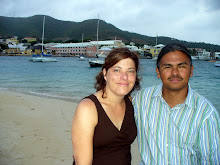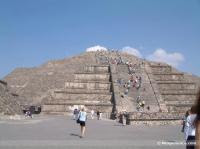We’ve spent the last couple of days exploring Oaxaca’s Centro area. Oaxaca is much smaller and more manageable than Mexico City, but there is still plenty to do. Both the city and surrounding towns have mercados (markets) where everything from fruits and vegetables, to shoes and clothes, to animals, to toys and crafts are sold.
 Yesterday, after having a delicious and cheap lunch at the Mercado 20 de Noviembre, which contains mostly food stalls, we checked out the Iglesia San Juan de Dios. Inside there are a number of well-done religious paintings, as well as paintings depicting the indigenous peoples’ conversion to Catholicism.
Yesterday, after having a delicious and cheap lunch at the Mercado 20 de Noviembre, which contains mostly food stalls, we checked out the Iglesia San Juan de Dios. Inside there are a number of well-done religious paintings, as well as paintings depicting the indigenous peoples’ conversion to Catholicism. Next we explored the Mercado Juarez, a veritable feast for the senses. My photographs do very little to encapsulate this indoor market, so I will try to paint a picture with words. Vendors selling all manner of items were crammed next to each other in their stalls. More than once I had to duck under piñatas, clothing, and inflatable toys. It was noisy too, with people talking, TVs running, a bird in a cage chirping. More compelling than the sights and sounds however, were the smells: ripe bananas, fresh flowers, people, food cooking, new leather, pungent bags of chilies…
Next we explored the Mercado Juarez, a veritable feast for the senses. My photographs do very little to encapsulate this indoor market, so I will try to paint a picture with words. Vendors selling all manner of items were crammed next to each other in their stalls. More than once I had to duck under piñatas, clothing, and inflatable toys. It was noisy too, with people talking, TVs running, a bird in a cage chirping. More compelling than the sights and sounds however, were the smells: ripe bananas, fresh flowers, people, food cooking, new leather, pungent bags of chilies… In need of a little refreshment, we headed to Chocolate Mayordomo. The states of Tabasco and Chiapas grow a great deal of cacao trees, and Oaxaca is home to a delicious group of chocolate producers. Chocolate has a long history in Mexico, dating to pre-Hispanic times when both the Maya and the Aztec used chocolate in religious rituals. In Oaxaca, chocolate is used in a mole (combined with spices and peanuts and made into a sauce for chicken or turkey) or combined with milk to make chocolate drinks. The above machines are used to make custom chocolate concoctions – cocoa beans, cinnamon sticks and almonds, for example, are ground together before being added to milk. We ordered cool chocolate drinks and were they ever tasty!
In need of a little refreshment, we headed to Chocolate Mayordomo. The states of Tabasco and Chiapas grow a great deal of cacao trees, and Oaxaca is home to a delicious group of chocolate producers. Chocolate has a long history in Mexico, dating to pre-Hispanic times when both the Maya and the Aztec used chocolate in religious rituals. In Oaxaca, chocolate is used in a mole (combined with spices and peanuts and made into a sauce for chicken or turkey) or combined with milk to make chocolate drinks. The above machines are used to make custom chocolate concoctions – cocoa beans, cinnamon sticks and almonds, for example, are ground together before being added to milk. We ordered cool chocolate drinks and were they ever tasty!We returned to the house for a couple of hours, and the headed back to the zocalo for dinner. The zocalo was even livelier than on Sunday. Zapotecs were selling their wares and a group commemorating the anniversary of a Oaxacan rebellion had posters, paintings and information all over the place.
 Today we headed to Amate Books, a small (by American standards) bookstore along the city’s pedestrian walkway (above). Selso and Rafael both needed new books, and the store had a terrific selection of English-language books for both adults and children, including many pertaining to Mexico.
Today we headed to Amate Books, a small (by American standards) bookstore along the city’s pedestrian walkway (above). Selso and Rafael both needed new books, and the store had a terrific selection of English-language books for both adults and children, including many pertaining to Mexico.
 We also stopped by the library, mostly because we were in search of bathrooms. The library is located in a charmingly restored former convent with a large central patio. We happened upon a collection of paintings temporarily on display, many by Antonio Martinez Irala.
We also stopped by the library, mostly because we were in search of bathrooms. The library is located in a charmingly restored former convent with a large central patio. We happened upon a collection of paintings temporarily on display, many by Antonio Martinez Irala.
 After lunch at the zocalo, we walked to Templo de San Felipe Neri. The church, like many other buildings in the area, has endured several earthquakes since its original completion in 1773, and has been restored. The altarpiece is three stories high, ornately carved and golden.
After lunch at the zocalo, we walked to Templo de San Felipe Neri. The church, like many other buildings in the area, has endured several earthquakes since its original completion in 1773, and has been restored. The altarpiece is three stories high, ornately carved and golden.
 Today we headed to Amate Books, a small (by American standards) bookstore along the city’s pedestrian walkway (above). Selso and Rafael both needed new books, and the store had a terrific selection of English-language books for both adults and children, including many pertaining to Mexico.
Today we headed to Amate Books, a small (by American standards) bookstore along the city’s pedestrian walkway (above). Selso and Rafael both needed new books, and the store had a terrific selection of English-language books for both adults and children, including many pertaining to Mexico. We also stopped by the library, mostly because we were in search of bathrooms. The library is located in a charmingly restored former convent with a large central patio. We happened upon a collection of paintings temporarily on display, many by Antonio Martinez Irala.
We also stopped by the library, mostly because we were in search of bathrooms. The library is located in a charmingly restored former convent with a large central patio. We happened upon a collection of paintings temporarily on display, many by Antonio Martinez Irala. After lunch at the zocalo, we walked to Templo de San Felipe Neri. The church, like many other buildings in the area, has endured several earthquakes since its original completion in 1773, and has been restored. The altarpiece is three stories high, ornately carved and golden.
After lunch at the zocalo, we walked to Templo de San Felipe Neri. The church, like many other buildings in the area, has endured several earthquakes since its original completion in 1773, and has been restored. The altarpiece is three stories high, ornately carved and golden.






Looks that you've gone to different places for trivial searches. Cool! I love the paintings.
ReplyDelete